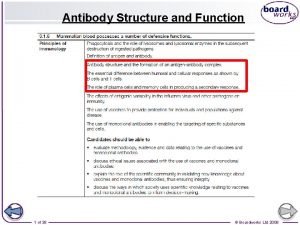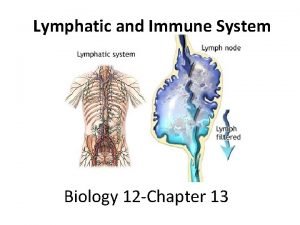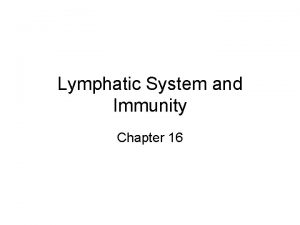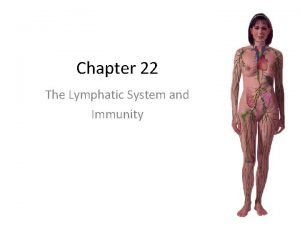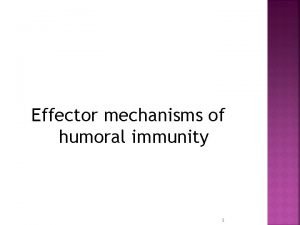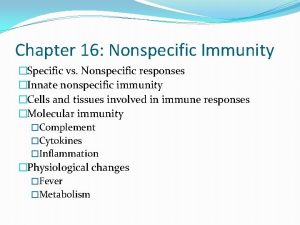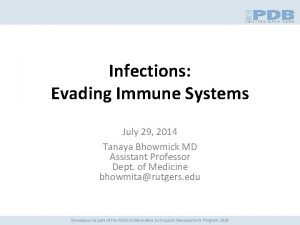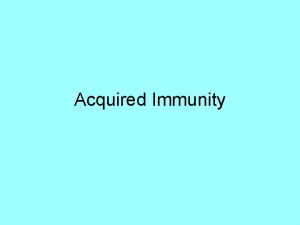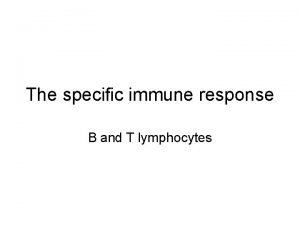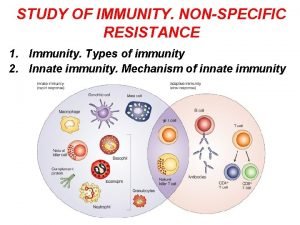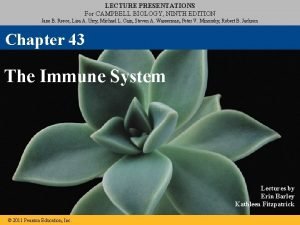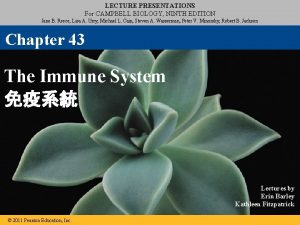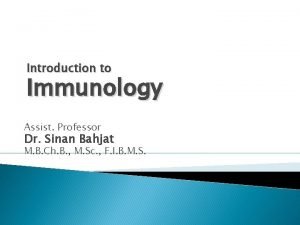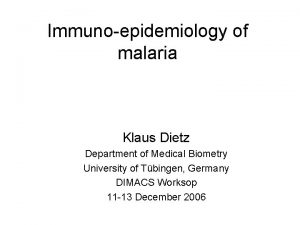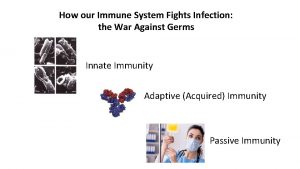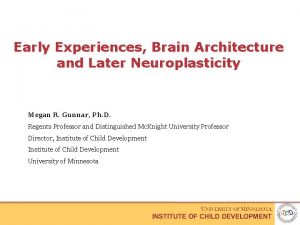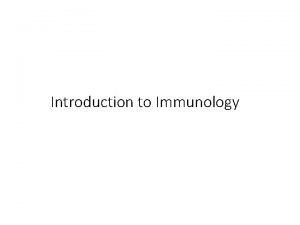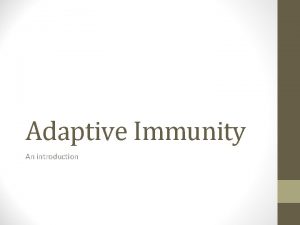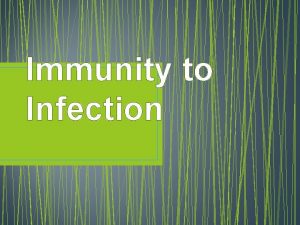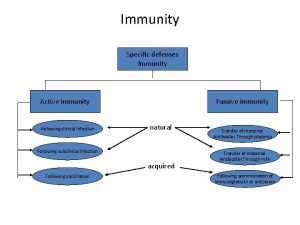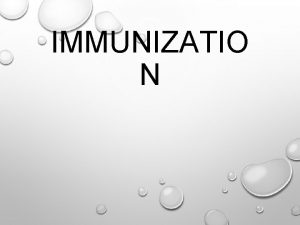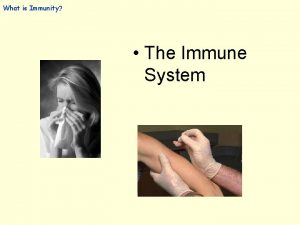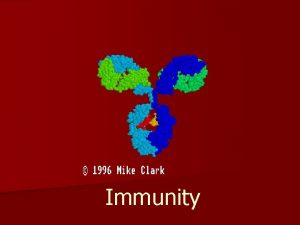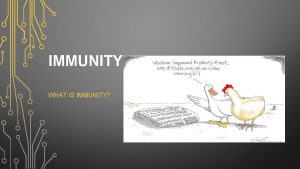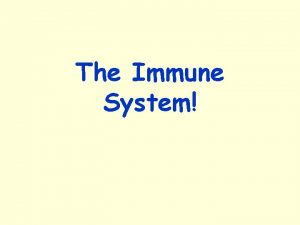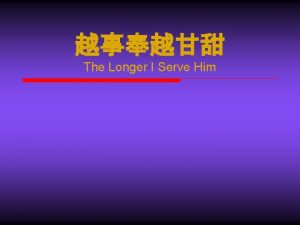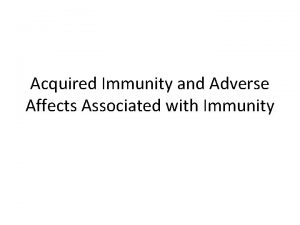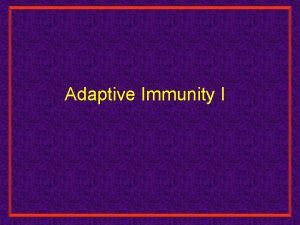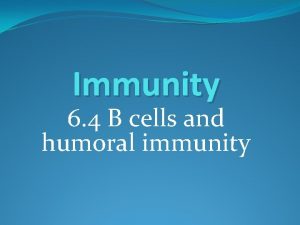Immunity New particles take longer to identify and


































- Slides: 34


Immunity - New particles take longer to identify, and a person remains ill until a new antibody can be crafted - Old particles are quickly recognized, and a person may never become ill from that invader again. - This person is now immune.

Innate (VS) Acquired


First Type of Acquired Immunity: Active Immunity - You produce the antibodies - Your body has been exposed to the antigen in the past either through: - Exposure to the actual disease causing antigen – You fought it, you won, you remember it - Planned exposure (Vaccine) to a form of the antigen that has been killed or weakened – You detected it, eliminated it, and remember it MEMORY CELLS

Second Type of Acquired Immunity Passive Immunity • You don’t produce the antibodies – A mother will pass immunities on to her baby during pregnancy - through what organ? Placenta Breastmilk Why doesn’t the mother just pass on the WBCs that “remember” the antigens? Passed on by the Mother Thymus

Antibiotics • Antibiotics: Work inside the body to kill bacteria that cause diseases by damaging the bacterial cells. – Do NOT work on viruses, because they live inside a body cell.

Antibiotic Resistance • Antibiotic Resistance: Some bacteria mutate by natural selection and become resistant to the antibiotic.

Vaccine • The bacteria or virus have been killed or weakened, in the vaccine, minimal symptoms occur. • Antigens are deliberately introduced into the immune system to produce immunity Have eradicated or severely limited several diseases from the face of the Earth, such as polio and smallpox.

Instead of the entire microbe, subunit vaccines include only the antigens. Body responds by producing antibodies a form of active immunity.

Types of Vaccines Live, Attenuated (weakened) Vaccines: • Contain a version of the living microbe that has been weakened in the lab so it can’t cause disease. • Because a live, attenuated vaccine is the closest thing to a natural infection, these vaccines are good “teachers” of the immune system: They elicit strong cellular and antibody responses and often confer lifelong immunity with only one or two doses. Inactivated Vaccines: • Scientists produce inactivated vaccines by killing the disease-causing microbe with chemicals, heat, or radiation.

How Vaccines Work • Create protective antibodies that are on the lookout for pathogens. • When they come across a pathogen, they activate cells to attack the pathogen right away. • Booster shots are used as reminders for your body to always stay on guard. • It is a safe controlled way to build immunity, so if in the future if the real pathogen ever shows up, your body will recognize it and keep that shows of immunity up for the rest of its life

How long does active immunity last? • It depends on the antigen • Some disease-causing bacteria multiply into new forms that our body doesn’t recognize, requiring annual vaccinations, like the flu shot • Booster shot - reminds the immune system of the antigen • Others last for a lifetime, such as chicken pox

First Vaccine

Smallpox

Mumps Rubella German Measles Chicken pox

c c a V Active Immunity e in

Which substances may form in the human body due to invaders entering the blood? • A) nutrients • B) vaccines • C) Red Blood Cells • D) antibodies

• An organism develops active immunity as a result of • I) manufacturing its own antigens • 2) producing antibodies in response to a vaccination • 3) receiving an injection of antibodies produced by another organism • 4) receiving an injection of a dilute glucose solution

Newborn infants nursing from their mother receive milk containing antibodies against diseases to which the mother is immune. The infants, however, remain immune to those diseases for only a short time. This situation is an example of • A) active immunity • B) an oral vaccine • C) passive immunity • D) a phagocytic activity

• An individual who has had small pox rarely gets this disease again. This situation is an example of • A) biological control • B) active immunity • C) negative feedback • D) passive immunity d o ib . s ie u o Y b r t n a s e c u d o r p y d o

• 2. In the 18 th century, smallpox was a common and deadly disease. A country doctor, Edward Jenner, observed that patients working with cattle who contracted a mild disease called cowpox, never came down with the more serious smallpox. When Jenner obtained liquid from cowpox sores and injected it into healthy patients, they became immune to smallpox. What term BEST describes Jenner’s treatment for smallpox? • • A-vaccination B-gene therapy C-chemotherapy D-genetic engineering

Bell Ringer # 1 • After an initial infection, B-cells recognize the measles virus. How is this helpful in human immune response? • A. The B-cells use this recognition to defend the body against other pathogens, such as bacteria. • B. The B-cells more quickly recognize and respond to any other virus that invades the body. • C. The B-cells produce antibodies more quickly if the measles virus is encountered again. • D. The B-cells transfer this recognition to T-cells, which will then devour the viruses.

“Super Bugs” • Many pathogens are building up resistance to antibiotics. • Superbugs can enter a patient through surgical wounds and catheters, including IVs. Uncontrolled, they continue to move throughout the body, attacking a person's organs.

Flesh Eating Bacteria Necrotizing fasciitis


Acquired Immune Deficiency Syndrome • Caused by the Human Immunodeficiency Virus • Discovered in 1983 • Specifically targets and kills Tcells • Because normal body cells are unaffected, immune response is not launched.

AIDS ~The Modern Plague~ - The HIV virus doesn’t kill you – it cripples your immune system - With your immune system shut down, common diseases that your immune system normally could defeat become lifethreatening - Can show no effects for several months all the way up to 10 years

AIDS ~The Silent Spread~ • Transmitted by sexual contact, blood transfusions, contaminate d needles

People with AIDS are unable to fight multiple infections because the virus that causes AIDS • A) weakens their immune systems • B) produces antibodies in their blood • C) attacks muscle tissue • D) kills pathogens

Which statement best describes how a vaccination can help protect the body against disease? A) Vaccines directly kill the pathogen that causes the disease. B) Vaccines act as a medicine that cures the disease. C) Vaccines cause the production of specific molecules that will react with and destroy certain microbes. D) Vaccines contain white blood cells that engulf harmful germs and prevent them from spreading throughout the body.

The purpose of introducing weakened microbes into the body of an organism is to stimulate the A) production of living microbes that will protect the organism from future attacks B) production of antigens that will prevent infections from occurring C) immune system to react and prepare the organism to fight future invasions by these microbes D) replication of genes that direct the synthesis of hormones that regulate the number of microbes

• Which statement best describes what will most likely happen when an individual receives a vaccination containing a weakened pathogen? • 1) The ability to fight disease will increase due to antibodies received from the pathogen. • 2) The ability to fight disease caused by the pathogen will increase due to antibody production. • 3) The ability to produce antibodies will decrease after the vaccination. • 4) The ability to resist most types of diseases will increase

An injection containing weakened forms of a disease causing organism will usually trigger • A) absorption of histamines throughout the body • B) secretion of antigens by lymphocytes • C) production of temporary resistance to the disease • D) production of antibodies providing active immunity
 Difference between acquired immunity and innate immunity
Difference between acquired immunity and innate immunity Take a bus or take a train
Take a bus or take a train Humoral and cell mediated immunity difference
Humoral and cell mediated immunity difference Chapter 13 lymphatic system and immunity
Chapter 13 lymphatic system and immunity Classification of immunity
Classification of immunity Chapter 16 lymphatic system and immunity
Chapter 16 lymphatic system and immunity Main components of lymphatic system
Main components of lymphatic system Hinge theorem examples with answers
Hinge theorem examples with answers Who witnessed the trampling of the young girl?
Who witnessed the trampling of the young girl? Difference between innate and learned behavior
Difference between innate and learned behavior Effector mechanism of humoral immunity
Effector mechanism of humoral immunity Specific vs nonspecific immunity
Specific vs nonspecific immunity Canra passed
Canra passed Adaptive noise immunity
Adaptive noise immunity Keva immunity booster
Keva immunity booster Innate immunity examples
Innate immunity examples Innate immunity examples
Innate immunity examples Conducted immunity test
Conducted immunity test Acquired immunity
Acquired immunity Acquired immunity definition
Acquired immunity definition Immunity
Immunity Active vs passive immunity
Active vs passive immunity Non-specific immunity
Non-specific immunity Neutrophil extracellular traps
Neutrophil extracellular traps Opsonization
Opsonization Cell mediated immunity
Cell mediated immunity Innate immunity first line of defense
Innate immunity first line of defense Innate immunity
Innate immunity Adaptative immunity
Adaptative immunity Types of antigen
Types of antigen Innate immunity first line of defense
Innate immunity first line of defense Passive immunity
Passive immunity Innate immunity first line of defense
Innate immunity first line of defense Innate immunity first line of defense
Innate immunity first line of defense Ciliary escalator
Ciliary escalator


